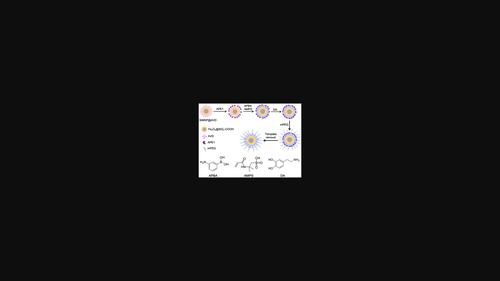当前位置:
X-MOL 学术
›
Biopolymers
›
论文详情
Our official English website, www.x-mol.net, welcomes your feedback! (Note: you will need to create a separate account there.)
Surface imprinted bio-nanocomposites for affinity separation of a cellular DNA repair protein
Biopolymers ( IF 2.9 ) Pub Date : 2023-03-27 , DOI: 10.1002/bip.23537 Huaisyuan Xie 1 , Ying Sun 1 , Ruilan Zhang 1 , Yuxuan Zhang 1 , Meiping Zhao 1
Biopolymers ( IF 2.9 ) Pub Date : 2023-03-27 , DOI: 10.1002/bip.23537 Huaisyuan Xie 1 , Ying Sun 1 , Ruilan Zhang 1 , Yuxuan Zhang 1 , Meiping Zhao 1
Affiliation

|
Apurinic/apyrimidinic endonuclease 1 (APE1) is a multifunctional DNA repair protein localized in different subcellular compartments. The mechanisms responsible for the highly regulated subcellular localization and “interactomes” of this protein are not fully understood but have been closely correlated to the posttranslational modifications in different biological context. In this work, we attempted to develop a bio-nanocomposite with antibody-like properties that could capture APE1 from cellular matrices to enable the comprehensive study of this protein. By fixing the template APE1 on the avidin-modified surface of silica-coated magnetic nanoparticles, we first added 3-aminophenylboronic acid to react with the glycosyl residues of avidin, followed by addition of 2-acrylamido-2-methylpropane sulfonic acid as the second functional monomer to perform the first step imprinting reaction. To further enhance the affinity and selectivity of the binding sites, we carried out the second step imprinting reaction with dopamine as the functional monomer. After the polymerization, we modified the nonimprinted sites with methoxypoly (ethylene glycol) amine (mPEG-NH2). The resulting molecularly imprinted polymer-based bio-nanocomposite showed high affinity, specificity, and capacity for template APE1. It allowed for the extraction of APE1 from the cell lysates with high recovery and purity. Moreover, the bound protein could be effectively released from the bio-nanocomposite with high activity. The bio-nanocomposite offers a very useful tool for the separation of APE1 from various complex biological samples.
中文翻译:

用于细胞 DNA 修复蛋白亲和分离的表面印迹生物纳米复合材料
脱嘌呤/脱嘧啶核酸内切酶 1 (APE1) 是一种多功能 DNA 修复蛋白,位于不同的亚细胞区室中。负责该蛋白质高度调节的亚细胞定位和“相互作用组”的机制尚未完全了解,但与不同生物学背景下的翻译后修饰密切相关。在这项工作中,我们试图开发一种具有抗体样特性的生物纳米复合材料,可以从细胞基质中捕获 APE1,从而能够对这种蛋白质进行全面研究。通过将模板APE1固定在二氧化硅包覆的磁性纳米颗粒的亲和素修饰表面,我们首先添加3-氨基苯基硼酸与亲和素的糖基残基反应,接着加入2-丙烯酰胺基-2-甲基丙磺酸作为第二功能单体进行第一步印迹反应。为了进一步提高结合位点的亲和力和选择性,我们进行了以多巴胺为功能单体的第二步印迹反应。聚合后,我们用甲氧基聚(乙二醇)胺(mPEG-NH2 ). 由此产生的基于分子印迹聚合物的生物纳米复合材料显示出对模板 APE1 的高亲和力、特异性和容量。它允许以高回收率和纯度从细胞裂解物中提取 APE1。此外,结合的蛋白质可以从具有高活性的生物纳米复合材料中有效释放。生物纳米复合材料为从各种复杂生物样品中分离 APE1 提供了非常有用的工具。
更新日期:2023-03-27
中文翻译:

用于细胞 DNA 修复蛋白亲和分离的表面印迹生物纳米复合材料
脱嘌呤/脱嘧啶核酸内切酶 1 (APE1) 是一种多功能 DNA 修复蛋白,位于不同的亚细胞区室中。负责该蛋白质高度调节的亚细胞定位和“相互作用组”的机制尚未完全了解,但与不同生物学背景下的翻译后修饰密切相关。在这项工作中,我们试图开发一种具有抗体样特性的生物纳米复合材料,可以从细胞基质中捕获 APE1,从而能够对这种蛋白质进行全面研究。通过将模板APE1固定在二氧化硅包覆的磁性纳米颗粒的亲和素修饰表面,我们首先添加3-氨基苯基硼酸与亲和素的糖基残基反应,接着加入2-丙烯酰胺基-2-甲基丙磺酸作为第二功能单体进行第一步印迹反应。为了进一步提高结合位点的亲和力和选择性,我们进行了以多巴胺为功能单体的第二步印迹反应。聚合后,我们用甲氧基聚(乙二醇)胺(mPEG-NH2 ). 由此产生的基于分子印迹聚合物的生物纳米复合材料显示出对模板 APE1 的高亲和力、特异性和容量。它允许以高回收率和纯度从细胞裂解物中提取 APE1。此外,结合的蛋白质可以从具有高活性的生物纳米复合材料中有效释放。生物纳米复合材料为从各种复杂生物样品中分离 APE1 提供了非常有用的工具。



























 京公网安备 11010802027423号
京公网安备 11010802027423号